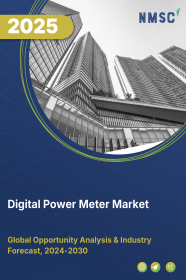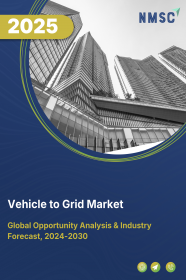
The Digital Power Meter Market by Phase Type (Single-Phase, Three-Phase, and Others), by Voltage Range (Low Voltage <1 kV, Medium Voltage 1–36 kV, and High Voltage >36 kV), by Price Range (Low-Cost Meters, Mid-Range Meters, and Premium Meters), by Technology (Wired and Wireless) and by Application (Residential, Commercial, and Industrial) - Global Opportunity Analysis and Industry Forecast 2025-2030
US Tariff Impact on Digital Power Meter Market
Trump Tariffs Are Reshaping Global Business
Digital Power Meter Industry Overview
The global Digital Power Meter Market size was valued at USD 10.22 billion in 2024 and is expected to be valued at USD 11.26 billion by the end of 2025. The industry is further predicted to reach USD 18.30 billion by 2030 with a CAGR of 10.2% from 2025-2030.
The digital power meter market is witnessing steady growth due to rising demand for real-time energy intelligence, increased investments in smart grid infrastructure, and supportive government policies promoting advanced metering systems. These meters offer high accuracy, remote accessibility, and data-driven energy management, making them essential for sectors aiming to optimize operational efficiency.
Government mandates and smart grid initiatives further accelerate adoption, especially in regions transitioning from legacy systems to modern digital solutions. However, high initial costs remain a challenge for smaller users and price-sensitive markets. On the contrary, rising adoption of renewable energy systems presents significant opportunities, as infrastructure development and energy management become top priorities for sustainable growth.
Surge in Real-Time Energy Intelligence for Operational Efficiency Drives the Market Growth
The escalating demand for precise and real-time power monitoring is a primary engine driving the digital power meter market growth. As energy consumption surges globally across residential, commercial, and industrial sectors, the necessity for effective energy monitoring and management tools becomes increasingly vital. Digital power meters offer enhanced accuracy, remote accessibility, and sophisticated data analytics compared to traditional analog counterparts, making them the preferred choice for users seeking to optimize energy utilization and reduce operational expenses.
For instance, in manufacturing plants, 3-Phase Digital Energy Meters enable precise monitoring of power consumption, facilitating operational efficiency and cost savings through data-driven decisions. Furthermore, smart meters, a type of digital power meter, empower industries to gain total control over their energy consumption, make informed decisions, and ultimately reduce their carbon footprint. This growing awareness of the benefits of detailed energy usage data is significantly boosting the market revenue and its overall growth potential.
Increasing Investments in Smart Grid Infrastructure Fuel the Market Expansion
The ongoing and increasing investments in smart grid infrastructure worldwide act as a significant catalyst for the digital power meter market expansion. Smart grids rely on advanced digital technologies, including smart meters, to enhance grid reliability, responsiveness, and efficiency. These investments are frequently driven by the need to modernize existing energy infrastructure, integrate renewable energy sources seamlessly, and improve overall grid management.
Digital power meters are crucial components of Automated Metering Infrastructure (AMI) systems within smart grids, enabling bidirectional communication between utilities and consumers. This infrastructure facilitates real-time data collection for energy forecasting, peak load management, and accurate billing. As countries like India actively pursue the installation of millions of smart meters under initiatives like the Smart Meter National Programme, the digital power meters market demand as a foundational element of smart grids continues to rise, contributing substantially to the sector's expansion.
Supportive Government Regulations and Policies Propel the Market Growth
Government regulations and policies worldwide that actively encourage the adoption of advanced metering infrastructure (AMI) are a crucial driver for the market growth. These supportive frameworks frequently mandate the replacement of traditional analog or even basic digital meters with smart meters, which provide more detailed and actionable energy consumption data.
Incentives and targets set by governments, such as India's goal to install 250 million smart meters by 2027 under the Revamped Distribution Sector Scheme (RDSS), directly fuel the demand for digital power meters. These policies aim to reduce energy losses, improve billing accuracy, empower consumers to manage their energy usage effectively, and facilitate the integration of renewable energy sources. Compliance with standards like IEC 61000-4-7 for harmonic measurement and meeting ENERGY STAR/EN 50564 /IEC 62301/ErP requirements is repeatedly part of these regulatory landscapes, further driving the adoption of sophisticated industrial energy metering.
High Initial Investment Costs Restrain the Market Growth
A notable restraint on the widespread adoption of digital power meters, particularly for smaller entities, is the high initial investment costs associated with their procurement and deployment. While the long-term benefits of digital power meters, such as reduced operational inefficiencies, more accurate billing, and enhanced energy management, are significant, the upfront expenditure can be a barrier. This is especially true for residential consumers and small to medium-sized enterprises (SMEs) who have budget constraints.
The cost extends beyond the meter itself to include the necessary infrastructure upgrades, IT integration, and skilled personnel for installation and maintenance. Balancing the long-term advantages with the immediate financial outlay remains a challenge that can potentially slow down the market's growth rate, especially in price-sensitive regions.
Adoption of Renewable Energy Systems Creates Opportunity for Market Growth
The rising adoption of renewable energy systems, such as solar and wind, presents a lucrative opportunity for the digital power meter market by necessitating advanced metering solutions to manage complex, bidirectional energy flows in decentralized grids. As global renewable energy capacity grows, projected to increase by 50% between 2023 and 2028 according to the International Energy Agency, the demand for smart power meters surges due to their ability to provide real-time data, enable demand-response programs, and ensure grid stability by integrating distributed energy resources (DERs). These meters facilitate precise monitoring of energy generation and consumption, critical for balancing intermittent renewable sources and supporting net-zero goals.
A recent company launch capitalizing on this trend is Itron’s September 2024 introduction of the AMI 7 Series smart electricity meter, designed to handle the complexities of modern energy demands by offering real-time analytics and efficient DER integration, enabling utilities to optimize grid performance and enhance resilience amidst growing renewable adoption.
Market Segmentation and Scope of Study
The digital power meter market report is segmented by phase type, voltage range, price range, technology, application, and region. On the basis of phase type, it is divided into single-phase, three-phase, and others. On the basis of voltage range, the market is segmented into low voltage (<1 kV), medium voltage (1–36 kV), and high voltage (>36 kV). On the basis of price range, the market is categorized into low-cost meters, mid-range meters, and premium meters. On the basis of technology, the market is bifurcated into wired and wireless. On the basis of application, the market is segmented into residential, commercial, and industrial. Regional breakdown and analysis of each of the aforesaid segments includes regions comprising North America, Europe, Asia-Pacific, and RoW.
Geographical Analysis
North America holds a significant position in the digital power meter market share, primarily due to its strong investments in research and development and a well-established industrial base. The region demonstrates increasing adoption of advanced digital power meter solutions across various sectors. The presence of key market players in North America further contributes to its market share and technological advancements. Factors such as the need for efficient energy management in commercial and industrial applications are driving the demand for digital power meters, contributing to the steady growth of the market in this region.
Europe represents another key region in the digital power meter market, driven by stringent regulations and sustainability initiatives. There is a strong focus on innovation and the adoption of smart metering systems to align with energy efficiency targets. Countries like Germany, France, and the UK are significant contributors to the European market size due to their robust industrial frameworks and technological expertise. The numerous reports on application-specific markets within Europe suggest a mature and diverse market with a growing demand for specialized digital power metering solutions across various industries.
The Asia-Pacific region is experiencing the fastest growth in the digital power meter market, fueled by rapid industrialization, urbanization, and increasing consumer demand. China, Japan, and India are crucial players in this expansion. Notably, India has an ambitious target to install 250 million smart meters by 2027 under the Revamped Distribution Sector Scheme (RDSS), presenting a substantial USD 20 billion opportunity in energy management. As of October 2024, significant progress has been made in awarding and installing these smart meters. This push towards advanced metering infrastructure (AMI) in India, where smart meters are considered a necessity for the power distribution sector, is a major driver for the Asia-Pacific market's growth potential and will significantly impact the global market share.
The Rest of the World, encompassing regions like Latin America and the Middle East, and Africa (MEA), represents emerging markets with growing potential for the digital power meter industry. Infrastructure development and expanding industrial sectors in these regions are driving the demand for more sophisticated energy monitoring solutions. While these markets offer growth opportunities, they also face challenges such as economic instability and regulatory barriers that could influence their growth trajectories compared to more developed regions. Nevertheless, as these economies continue to develop and focus on energy efficiency, the adoption of digital power meters is expected to increase, contributing to the overall expansion of the global industry size.
Key Strategies Adopted by Companies
In the dynamic digital power meter industry, key players are strategically focusing on product innovation and technological advancements to maintain and grow their market share in a landscape characterized by evolving energy demands and increasing emphasis on efficiency. For instance, companies are investing heavily in research and development to integrate advanced digital technologies such as Artificial Intelligence (AI) and the Internet of Things (IoT) into their offerings, enhancing features like real-time monitoring, predictive analytics, and seamless integration with smart grid infrastructure.
A notable recent development is the strong push towards smart metering solutions, particularly in regions like Asia-Pacific, exemplified by India's ambitious Smart Meter National Programme, aiming for 250 million installations by 2027, representing a substantial market opportunity. This initiative is a direct response to the need for reduced Aggregate Technical and Commercial (AT&C) losses and improved billing efficiency.
However, these key players face challenges such as high initial investment costs associated with deploying advanced metering infrastructure and regulatory complexities that vary across different regions. Intense market competition also necessitates continuous innovation to differentiate products and maintain profitability.
Looking ahead, the growth potential of the market is significant, driven by the global focus on energy efficiency, sustainability, and the integration of renewable energy sources. The increasing adoption of digital power meters in residential, commercial, and industrial sectors, coupled with the rise of smart homes and electric vehicles, presents substantial opportunities for market expansion.
Key Benefits
-
The report provides quantitative analysis and estimations of the industry from 2025 to 2030, which assists in identifying the prevailing digital power meter market opportunities.
-
The study comprises a deep dive analysis of the current and future digital power meter market trends to depict prevalent investment pockets in the sector.
-
Information related to key drivers, restraints, and opportunities and their impact on the sector is provided in the report.
-
Competitive analysis of the key players, along with their market share, is provided in the report.
-
SWOT analysis and Porter's Five Forces model are elaborated in the study.
-
Value chain analysis in the market study provides a clear picture of the roles of stakeholders.
Digital Power Meter Market Key Segments
By Phase Type
-
Single-Phase
-
Three-Phase
-
Others
By Voltage Range
-
Low Voltage (<1 kV)
-
Medium Voltage (1–36 kV)
-
High Voltage (>36 kV)
By Price Range
-
Low-Cost Meters
-
Mid-Range Meters
-
Premium Meters
By Technology
-
Wired
-
Wireless
By Application
-
Residential
-
Commercial
-
Industrial
By Region
-
North America
-
The U.S.
-
Canada
-
Mexico
-
-
Europe
-
The UK
-
Germany
-
France
-
Italy
-
Spain
-
Denmark
-
Netherlands
-
Finland
-
Sweden
-
Norway
-
Russia
-
Rest of Europe
-
-
Asia-Pacific
-
China
-
Japan
-
India
-
South Korea
-
Australia
-
Indonesia
-
Singapore
-
Taiwan
-
Thailand
-
Rest of Asia-Pacific
-
-
RoW
-
Latin America
-
Middle East
-
Africa
-
Key players
-
ABB Ltd.
-
Itron Inc.
-
Siemens AG
-
Schneider Electric SE
-
General Electric Company
-
Mitsubishi Electric Corporation
-
Accuenergy Inc.
-
Acrel Co Ltd
-
Landis+Gyr AG
-
Hottinger Brüel & Kjær
-
Delta Electronics, Inc.
-
AJAY ELECTRICAL INDUSTRIES
-
S L Trading Co.
REPORT SCOPE AND SEGMENTATION:
|
Parameters |
Details |
|
Market Size in 2024 |
USD 10.22 Billion |
|
Revenue Forecast in 2030 |
USD 18.30 Billion |
|
Growth Rate |
CAGR of 10.2% from 2025 to 2030 |
|
Analysis Period |
2024–2030 |
|
Base Year Considered |
2024 |
|
Forecast Period |
2025–2030 |
|
Market Size Estimation |
Billion (USD) |
|
Growth Factors |
|
|
Countries Covered |
28 |
|
Companies Profiled |
15 |
|
Market Share |
Available for 10 companies |
|
Customization Scope |
Free customization (equivalent to up to 80 working hours of analysts) after purchase. Addition or alteration to country, regional, and segment scope. |
|
Pricing and Purchase Options |
Avail customized purchase options to meet your exact research needs. |

















 Speak to Our Analyst
Speak to Our Analyst





















